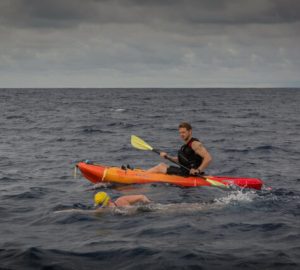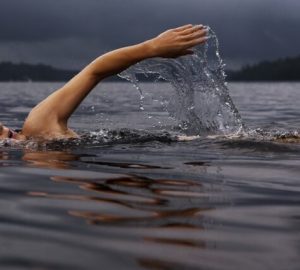Are you in control of your feet when you swim?
How much are you aware of your kick when you swim? And how important do you think it is? Until relatively recently I had the following beliefs about kicking in front crawl swimming:
- Kicking adds little if any speed to your swim – especially in long distance swimming or when wearing a wetsuit – therefore the best policy was not to put any effort into kicking.
- There was no need to worry about timing as perfect co-ordination happens naturally.
- Kicking ‘hard’ produced a six-beat kick, otherwise the default would be a balancing two-beat kick.
- If your legs and feet aren’t doing any harm (e.g. sinking or kicking out sideways) you can safely ignore them.
Consequently, my front crawl stroke development focus has almost always been on anything but what my legs and feet were doing – breathing, head position, hand entry, body rotation, catch and pull through were enough to concentrate on without worrying about my legs, which (I believed) were taking care of themselves. This was re-enforced over the years by various coaches and stroke analysts who have always identified things to improve on at the front end of my stroke – primarily with the arms and hands.
So, it was a bit of a surprise when I asked Tracey Bauman, a Total Immersion Master Coach who runsSwimSolutionS in Wraysbury, to film me swimming and give me some feedback.
“Your kick timing is totally out,” she told me. My initial reaction was to shrug. So what, I thought?
Well, more than I first assumed, it turns out. In swimming you really do have to look at the entire body as a system. What you do at one end impacts what happens at the other. Kicking may not add much propulsion but a properly timed kick really helps with body position and your ability to apply power to the water with your hands and arms.
My default, no-thought kick patten was an untidy, unorganised six-beat flutter that was disconnected from my upper body movements.
Whether you use a six-beat or a two-beak kick, ideally the left foot should be kicking down as the left hand pulls through the water, and right foot with right arm. Tracey encouraged me to try a two-beat kick with that timing.
I was surprised to find I had no sense of what my legs and feet were doing and therefore no means to control them. My initial efforts were laughable, and trying to figure out what my legs were doing caused me to lose control of my arms. I was simply unable to do what I was asked. Eventually Tracey had to get in the water and move my feet for me before I could even tell what they were doing.
I then went away and practised by kicking on my back and timing the hip rotations with the kick. Once I had mastered it on my back, I flipped over onto my front and eventually added the arms back in. It was only at this stage, after more than 40 years of swimming, that I finally had any idea what my legs were doing and had any control above kicking hard or not kicking hard.
I can now, for the first time in my life, swim with a deliberate two-beat kick. It’s not perfect yet – my left leg ‘wants’ to kick early every time, for example, and I can only really do it well in slow motion – but at least now I know what my feet are doing and have a bit of control over them.
Has it made me a faster swimmer? That is the ultimate goal of course. The answer is ‘not yet’ but it’s still early days. I have moments when swimming with a two-beat kick feels perfect and it’s great to feel my entire body working as a single unit. It’s added a new dimension to my swimming and it’s particularly satisfying to use on long distance open water swims. When the rhythm clicks I feel I could swim for hours. Other times I struggle with the co-ordination and swimming feels awkward – especially when I try to swim faster or in the pool where the turns every 25m disrupt the timing.
What I’ve enjoyed most of all is the process of exploring what was happening with my legs and learning how to control them. I’ve also changed what I think about kicking in front crawl:
- Kicking adds little propulsion when swimming long distances – but a well timed kick adds power and balance to your overall stroke.
- Perfect kick timing might not be happening automatically.
- A good two-beat kick is a deliberate action, not just the result of ignoring your legs or not kicking hard.
- If your legs and feet aren’t doing any harm (e.g. sinking or kicking out sideways) that’s a good place to start (and if not, it’s something worth aiming for) but they could be doing much more.
In my experience, the coaching of kicking is relatively neglected compared to the rest of stroke mechanics. I think there is an assumption that it happens automatically, much like you naturally swing your arms when you run. But that assumption, at least in my case, was wrong. So why not think about your legs and feet next time you swim and see if you can figure out what they are doing?
Also, check out our article by Terry Laughlin on developing a two-beat kick in the Dec 14/Jan 15 issue of H2Open Magazine.






